Director’s appointments bring total to 15 in Sandia’s history
Sandia has appointed six technically outstanding researchers to the extraordinary position of Fellow. The new appointees, from a wide variety of backgrounds, include the first female Sandia Fellow, Katherine Hansen Simonson, and the first Hispanic Sandia Fellow, Gil Herrera.
In announcing the Fellows, Labs Director Steve Younger wrote, “Appointment as a Sandia Fellow recognizes a career of significant accomplishment for the Labs and for the nation. I am asking each Fellow, new and existing, to take a greater role in informing strategic directions at the Labs.
Steve continued, “I would also ask that they serve as ambassadors for the Labs to organizations such as the Department of Energy, other government agencies, academia and technical societies. With their wealth of experience and knowledge, they are well suited as trusted advisors on a wide range of technical topics.”
Said Grant Heffelfinger, deputy Labs chief research officer, “The Fellow appointment is not solely an honorific, but a position with responsibilities for people of technical accomplishment and a track record of impact.”
Candidates are initially selected based on input from the technical divisions. Submitted forms are reviewed by a high-level panel led by Susan Seestrom, chief research officer and associate labs director for advanced science and technology. Those who make it through the winnowing process are interviewed by Steve, on whose shoulders rest the final decisions.
“The Fellow appointment is not solely an honorific, but a position with responsibilities for people of technical accomplishment and a track record of impact.”
Previous to the six appointments, Sandia has named only nine Fellows in its history. Seven are retired: Jerry Simmons, Jim Gosler, Gordon Osbourn, John Rowe, Gus Simmons, Wendell Weart and Walt Herrmann. Those who continue to serve as Sandia Fellows are Jeff Brinker and Ed Cole.
An on-site reception is planned where colleagues can visit with the new Fellows. Also planned is a private dinner for the Fellows and their immediate families with senior management.
The newly appointed fellows are:
David Chandler
Dave is an internationally renowned gas phase physical chemist. He is a fellow of the American Physical Society and has been elected by his peers as chairman of the society’s division of chemical physics. He has published over 120 refereed articles with more than 4,000 citations.
Dave’s father, William H. Chandler, was a longtime Sandia employee, and Dave grew up swimming in the Coronado Club pool, which then was on the Labs campus. He was awarded a gymnastics scholarship to the University of New Mexico, received a bachelor’s and doctorate in chemistry from Indiana University, went to Stanford University for post-doctoral work and joined Sandia in Livermore in 1982. There, he said, he was awarded the last lab available at the Combustion Research Facility.
His research has focused on photochemistry of small organic molecules to understand bond energies and energy transfer in small molecules. He designed and built a new type of apparatus that measured the speed of slowly moving charged particles.
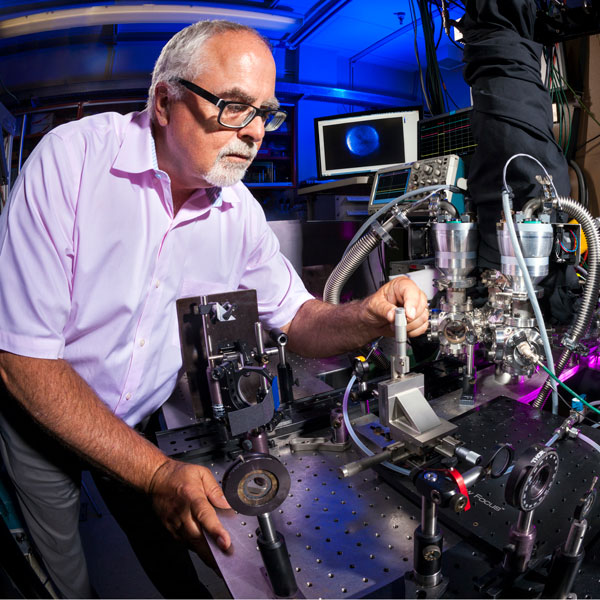
“Since one can easily turn a neutral atom or molecule into a charged particle by exposing it to light of sufficient energy to eject an electron in this new technique, it also measured the velocity of neutral particles,” Dave explained.
The technique, called ion imaging, has become the standard for measuring velocity in many chemical reactions. The invention earned him the Herbert P. Broaida award from the American Physical Society. More than a hundred groups around the world now use some variant of this technique.
In his spare time, Dave helped some friends start an educational toy company.
“I enjoyed the fun of product development with them for many years,” he said.
He writes of his plans, “As program manager for the Basic Energy Sciences, Gas Phase Chemical Physics programs at Sandia, I envision further strengthening these fundamental science programs and finding connections of this research and capabilities with other core mission areas within Sandia.”
Patrick Griffin
Patrick has expanded the state of the art in radiation effects to become an acknowledged leader in the international radiation effects community. Pat developed the NuGET code, a major tool for nuclear weapon qualification, and contributed greatly to the development of the radiation qualification process.
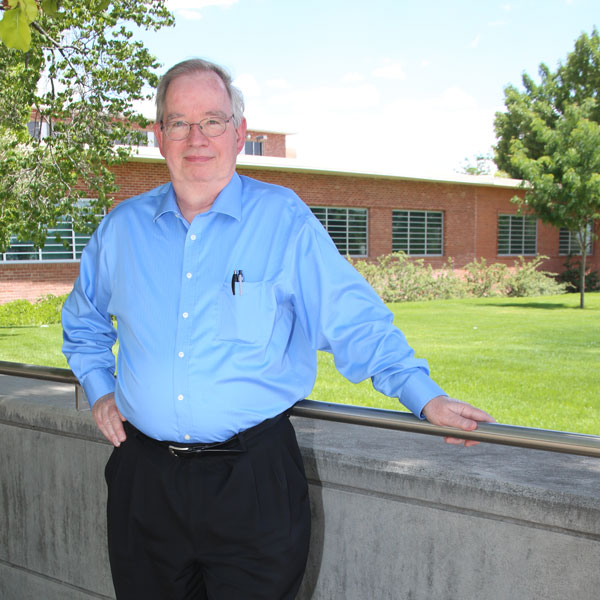
He grew up in Mineral Ridge, Ohio, a small town near Cleveland, achieving his bachelor’s in physics and mathematics and doctorate in nuclear physics at Ohio University.
Characteristically starting from first principles, the first item on his list of important achievements is Eagle Scout.
“I am stubborn and do not like to fail,” Patrick said. “The first year I went as a Boy Scout to summer camp, I had never learned to swim. I was embarrassed, being restricted to the shallow part of the lake near the dock. Following that summer, I worked hard on improving my swimming and, when I came back to Boy Scout summer camp the next year, I not
only qualified as a competent swimmer with full access to the lake, but I earned the mile swim badge. “
This stubbornness enabled him to do academics his way.
“My former physical chemistry professor told me after class one day that I had driven him crazy when he graded my p-chem tests because I always got the correct answer but I did not use the expected formula, so he had to look very carefully at my work to ensure that it followed logically from accepted formulas. It did, but it flowed along a longer path and from a different set of baseline expressions than was typical. Rather than memorize a lot of formulae, I made sure that I knew the basic building blocks and then worked out the expression needed for a given application.”
Patrick the student wasn’t asking much: he just wanted things explained from a “first principles” standpoint.
“When my freshman year physics courses failed to get down to what I considered the true fundamentals, I stopped taking physics courses as a sophomore and concentrated on mathematics and chemistry instead. I got back into physics as a junior when the classical mechanics, electromagnetism and quantum mechanics classes finally began to address things from a fundamental standpoint. Once my studies of physics began to approach things from first principles, I had found my home. I ended up completing the classroom work for a triple major – physics, chemistry and mathematics – but I was now a physicist at heart. And, like a 2 year old, I could continue to always ask the question ‘why,’ but now, unlike a 2 year old, I had the tools to try to answer/probe the questions myself.”
In his new role as a Sandia Fellow, he envisions working with NNSA and the Defense Threat Reduction Agency to better understand the vulnerability of the nuclear stockpile to evolving threats. He also intends to maintain strong relationships with colleagues in the Department of Defense to improve the characterization of radiation requirements, and to continue to engage with the international community to achieve a better scientific understanding of the physics behind radiation damage to materials.
He hopes to inspire young Sandia staff members to improve the description of the primary damage from neutron displacement and to provide a higher-fidelity model for neutron damage in semiconductors. Another goal is to engage Sandia’s statisticians with the radiation damage community and start an internal initiative to apply a rigorous statistical approach to the understanding and quantification of radiation damage.
Gilbert Herrera
Gil has made extensive contributions to nuclear weapons and other Sandia missions for customers in DOE, NNSA, the Department of Defense and the intelligence community through his expertise in micro and nanotechnologies.
Gil was born and raised in Albuquerque, “from Northern New Mexico families who lived in the Española Valley since Oñate.”
He started his undergraduate degree at the United States Military Academy but was injured playing college football. He received an honorable discharge from the Army, and continued his education at the University of New Mexico, earning his bachelor’s in computer engineering and a master’s in electrical engineering from the University of California, Berkeley, as a participant in Sandia’s One Year on Campus Program.
Gil led the start-up of Sandia’s MESA facilities,
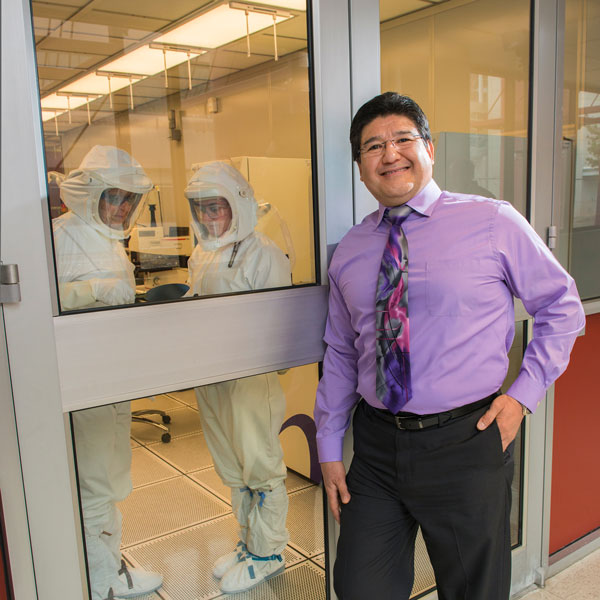
and served 8 ½ years as director there. He secured funding to sustain the Silicon Fab, and prepared the facilities for major nuclear weapon component production. His efforts included both a new approach to delivering radiation-hardened integrated circuits that saved time and money, and the first delivery of a compound semiconductor component to the nuclear stockpile.
He has been director of the Laboratory for Physical Sciences at a joint University of Maryland/U.S. Government research institute, and served at the White House Office of Science and Technology Policy as an AAAS/Sloan Fellow under President George H.W. Bush’s science advisor D. Alan Bromley, where he worked on U.S. semiconductor and technology transfer policy. He has received numerous awards for his service, including three Civilian Service medals from the Pentagon and the National Security Agency Research Medallion.
He is a fellow of the American Association for the Advancement of Science, a senior member of the Institute of Electrical and Electronics Engineers and a fellow of the University of Texas Institute for Advanced Technologies.
For his new station as Labs Fellow, he envisions contributing to the LDRD program and Advanced Science and Technology strategy, working with other Lab Fellows and senior scientists on issues identified by Steve and the associatelabs directors.
“The main areas I envision are working with others across the laboratory on the cultural and institutional barriers that inhibit the transition of technology from research to mission application, with an emphasis on the nuclear weapon program,” he said. “I also plan on continuing to work with the intelligence community on work associated with my recent assignment to NSA.”
He also looks forward to mentoring: helping people who are struggling with the decision whether to pursue a management or technical career path, new employees trying to establish themselves within Sandia, people and teams working on technology transfer issues and teams formulating new research proposals.
M. Keith Matzen
Keith is a preeminent scientist, manager and leader who has shaped the future of national security through his work to develop and apply pulsed power drivers to important problems in high energy density science and inertial confinement fusion.
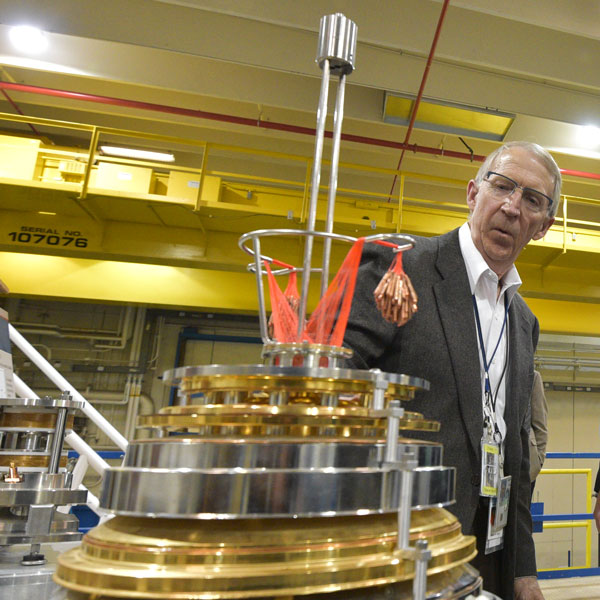
Keith, born and raised in Nebraska, received his bachelor’s in physics and chemistry from Hastings College and his doctorate in physical chemistry (kinetic theory) from Iowa State University.
“Over the last few decades, I have had the great pleasure of working with many different teams who advanced the science and technology of generating and accurately measuring the properties of extreme states of matter in pulsed power facilities,” he said. “With short pulses of very large electrical currents, the associated magnetic field pressures can drive materials to temperatures of millions of degrees Kelvin and pressures of millions of atmospheres, often called High Energy Density science or HED.”
With each new generation of pulsed-power drives, the number of applications grew and now includes radiation effects science, radiation physics, fusion physics (both indirect x-ray drive and magnetic direct drive), dynamic material properties and various physics issues associated with the performance of the nuclear explosive package,” Keith said.
“Collaborations with university research groups have led to fascinating progress in astrophysics (for example, physics issues in stars like our sun, white dwarf photospheres and black hole accretion disks) and planetary science (such as the physics of the structure of Earth and super-earths, Jovian planets and formation of the earth-moon system)” he continued.
By many measures, Keith said, HED science is still a young scientific field.
“Our teams at the Z facility have had phenomenal achievements with our experimental and theoretical tools, and my job for many years has been to try to provide some guidance and resources plus a research environment within which they can succeed,” Keith said.
“As a laboratory Fellow, I would like to work on refining the requirements for the HED capabilities that are needed to close existing gaps in our stockpile stewardship program and support our national security and nuclear deterrence strategies.” he said. “The next step is to determine how to provide these HED capabilities within the larger framework of national security science and technology requirements.”
Keith is a fellow of the American Physical Society and the recipient of the Fusion Power Associates Leadership Award.
Before taking on this new role, Keith has agreed to continue to serve as director of the Pulsed Power Sciences Center until his successor is named.
William M. Miller
Bill is a physicist who has demonstrated significant breadth and depth in the performance of multiple Sandia and national-level assignments over his career. Bill’s work in microelectronics reliability was groundbreaking.
Bill grew up on the West Coast, son of a Navy career veteran. Bill’s degrees, all in physics, include a bachelor’s from University of Washington and a master’s and doctorate, both from the University of Illinois.
He writes, “When I was in sixth grade, my parents started to buy me popular technical magazines on an irregular basis. One of those, Popular Mechanics, published in April 1969, had a feature article entitled “The Super Lab That Nobody Knows” (April 1969 p. 124-127, 217), which described Sandia and its cutting-edge work,” Bill recalls. “I was fascinated and read that article over and over, thinking as a child of 13 that Sandia would be a neat place to work.
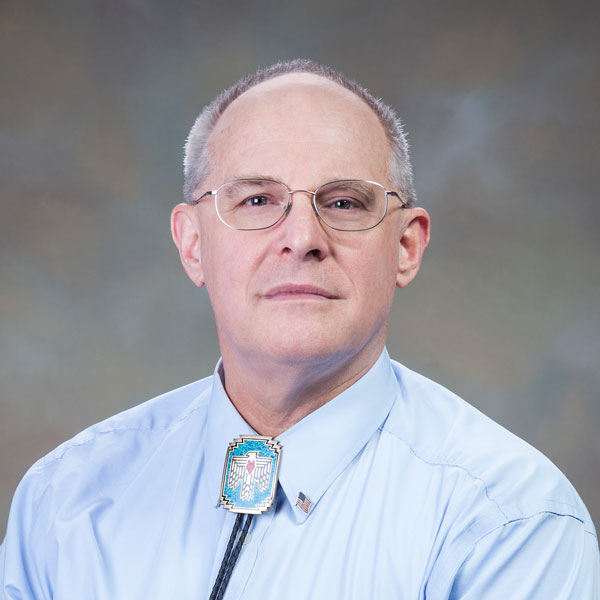
“Fifteen years later, with my Ph.D. defense just months away, I started to pay close attention to recruiting posters. There was one for Sandia — the same Sandia that I had read about as a child. I signed up, interviewed, was offered a job and accepted. By the way, my recruiter, Harry Hjalmarson, is still employed here.”
Katherine Hansen Simonson
Katherine has made important contributions to Sandia and the national security community in the field of statistics and data analysis. She is highly regarded in the Automatic Target Recognition and Space Mission communities and has received numerous Sandia awards, including the Laboratory Directed Research and Development Award of Excellence, various Employee Recognition Awards and Classified Inventor awards. She recently was selected to serve on the U.S. Air Force Scientific Advisory Board Federal Advisory Committee.
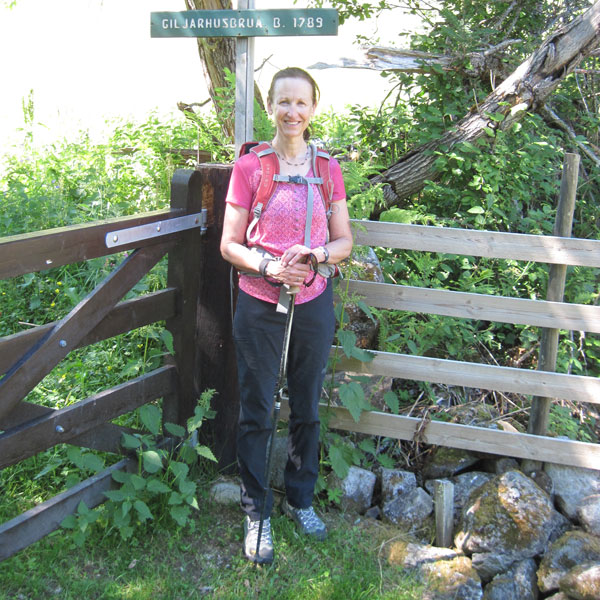
Katherine grew up in the Boston area and earned a bachelor’s in mathematics from Middlebury College in Vermont, minoring in literature.
“Middlebury, a liberal arts college, had a strong focus on the development of writing skills, and I feel that this has served me well throughout my career,” she said.
She spent her junior year at Vanderbilt University, where she took her first two courses in statistics and, she said, “fell in love with the field.” She achieved her master’s and doctorate at Princeton, both in statistics. Her dissertation focused on the development of data analytic techniques for application in geophysics and structural geology.
At Sandia, she’s worked on automatic target recognition systems for synthetic aperture radar sensors and new techniques for advanced SAR exploitation. “Sandia and our sponsors were ahead of the times in the 1990s, but the military community has since accepted the need for automated image exploitation,” she said.
She has also developed a range of mathematically rigorous data analytic techniques widely used in the near-real time detection, classification and geolocation of threat signatures, often providing orders-of-magnitude improvement over pre-existing technologies.
“Several of the statistical techniques that I first developed in graduate school are still regularly cited and applied in the areas of geophysics and epidemiology,” she said. “My work came at just the right time, as these fields were rapidly becoming more quantitative in nature.
She looks forward to providing technical expertise and strategic guidance to Sandia programs that are focused on data analysis and exploitation, saying, “Sandia is well-positioned for a leadership role in data analytics, and I will assist in bringing this potential to fruition.”
“I think that the most useful advice that I can give to Sandia’s future leaders is to live outside of your comfort zone,” she said. “Learn about the priorities and constraints associated with mission areas that are entirely new to you, attend research seminars that you don’t expect to understand and look for opportunities to apply your knowledge and skills in unforeseen applications. Through constant exposure to a wide cross-section of technical ideas and mission needs, you can position yourself to make revolutionary contributions to Sandia and the nation.”